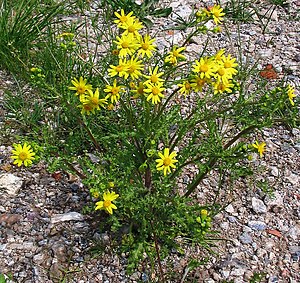Spring ragwort
| Spring ragwort | ||||||||||||
|---|---|---|---|---|---|---|---|---|---|---|---|---|

Spring ragwort ( Senecio leucanthemifolius subsp. Vernalis ) |
||||||||||||
| Systematics | ||||||||||||
|
||||||||||||
| Scientific name | ||||||||||||
| Senecio vernalis | ||||||||||||
| Waldst. & Kit. |
The Spring groundsel ( Senecio Leucanthemifolius subsp. Vernalis , Syn. : Senecio vernalis ) is a representative of the genus of Senecio ( Senecio ) and the family belongs Korbblütler on.
description
The spring ragwort reaches a height of 50 cm. On nutrient-rich soils, it can rarely even grow to 80 cm. It blooms from May to October. The leaves are densely spider-like and woolly on both sides, but often lose this hairiness with aging. The leaf blade is pinnate, the individual sections are egg-shaped and roughly toothed. The 6 to 12 outer bracts have a bald tip and are almost black to the tip. In the flower head there are a total of 21 bracts, so mostly 9 to 15 inner bracts. The flower heads have a diameter of about 2.5 cm and are inclined like a bell. There are usually 13 ray florets. The individual flowers are light yellow to golden yellow in color. The pappus is permanent and the fruits are hairy.
The flowering period is April to May, but can also last until November.
The number of chromosomes is 2n = 20.
Occurrence
The original distribution area of the spring ragwort includes the Balkan Peninsula with Bulgaria and Romania, Ukraine, Moldova, Belarus, Hungary, the Caucasus region, Turkmenistan, Turkey, Syria, Lebanon, Israel, Jordan, Iraq, Iran and Cyprus. In the rest of Europe, the species is a neophyte . The spring ragwort is scattered or rare in Germany . In Austria it occurs frequently in almost all federal states except for Vorarlberg and Upper Austria . Presumably it immigrated from Eastern Europe around 1850. That is why we consider it a neophyte. It probably first spread along railroad tracks. That is why there are still some deposits along train tracks and at train stations. In Germany, immigration from east to west took place in the second half of the 19th century. After initially appearing in large numbers, for example in fields, the species has sometimes become rarer again in the decades thereafter.
The spring ragwort grows preferentially in semi-arid ruderal areas , on relatively nutrient-rich lawns, on fallow land and loamy fields. It thrives on summer-warm, moderately dry, nutrient-rich, mostly low-lime, low-humic, loose loam or sandy soils. It is a character species of the class Chenopodietea, but also occurs in societies of the association Aperion spicae-venti. It can be found in Germany from the lowlands to colline areas. In Asia, however, it occurs higher, for example on Ararat in Turkey up to about 2800 meters above sea level.
Systematics
Spring ragwort is a subspecies of Senecio leucanthemifolius . From it, according to the investigations of Joachim W. Kadereit 1984–1985, the common groundsel ( Senecio vulgaris ) developed through chromosome duplication .
ecology
The flowers are pollinated by insects and the seeds are spread by the wind.
The spring ragwort is attacked by the rust fungus Puccinia lagenophorae .
Toxicity
Spring ragwort is not only poisonous for cows and horses. It contains pyrrolizidine alkaloids , which can damage the liver and cause cancer. However, symptoms of poisoning often only appear after weeks and can even occur from cow's milk.
photos
literature
- Manfred A. Fischer, Wolfgang Adler, Karl Oswald: Excursion flora for Austria, Liechtenstein and South Tyrol . 2nd, improved and enlarged edition. State of Upper Austria, Biology Center of the Upper Austrian State Museums, Linz 2005, ISBN 3-85474-140-5 .
further reading
- Reiner Harms: Properties of recombinant sym-homospermidine synthase and deoxyhypusine synthase from Senecio vernalis. Dissertation Univ. Braunschweig (PDF file).
Individual evidence
- ↑ a b Erich Oberdorfer : Plant-sociological excursion flora for Germany and neighboring areas . With the collaboration of Angelika Schwabe and Theo Müller. 8th, heavily revised and expanded edition. Eugen Ulmer, Stuttgart (Hohenheim) 2001, ISBN 3-8001-3131-5 , pp. 956 .
- ^ A b Senecio in the Germplasm Resources Information Network (GRIN), USDA , ARS , National Genetic Resources Program. National Germplasm Resources Laboratory, Beltsville, Maryland. Retrieved March 11, 2018.
- ^ A b c Gerhard Wagenitz : Family Compositae . In Gustav Hegi : Illustrated Flora of Central Europe . 2nd edition Volume VI, Part 4, pages 781-787, 1381-1382. Paul Parey Publishing House, Berlin, Hamburg 1987. ISBN 3-489-86020-9
- ↑ Eilam, Tamar, WR Bushnell, and Y. Anikster. "Relative nuclear DNA content of rust fungi estimated by flow cytometry of propidium iodide-stained pycniospores." Phytopathology 84.7 (1994): 728-734. pdf
Web links
- Spring ragwort. In: FloraWeb.de.
- Spring ragwort . In: BiolFlor, the database of biological-ecological characteristics of the flora of Germany.
- Profile and distribution map for Bavaria . In: Botanical Information Hub of Bavaria .
- Senecio vernalis Waldst. & Kit. In: Info Flora , the national data and information center for Swiss flora . Retrieved June 7, 2016.
- Distribution in the northern hemisphere from: Eric Hultén, Magnus Fries: Atlas of North European vascular plants. 1986, ISBN 3-87429-263-0 at Den virtuella floran. (Swedish)
- Thomas Meyer: Greiskraut data sheet with identification key and photos at Flora-de: Flora von Deutschland (old name of the website: Flowers in Swabia )
- Images: Biopix , Natural History Museum Vienna




